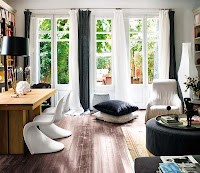INTERIOR DESIGN
When it comes to redecorating your home, but don’t have
enough budget to hire the professionals to do for you. -- Having the same problem? -- Ah...I
think you may need to read the secrets of do-it-yourself home decorating below.
Actually, there are some basic interior design principles you
may need to consider to make your room look more fabulous. In addition, you
also need to consider color, texture, light, and other specific elements, but for
now…better get started with the basic principles that will make a greater
impact to your place.
HARMONY
Harmony
Make sure that the arrangement of furniture fit the style of
your furnishings. The mood of the room is unified. For example, if you decide
to go for a minimalist & modern look, you should always keep your space
clutter-free.
However, harmony doesn’t expel the chance for contrast.
Using opposing elements like modern and traditional items can also be
successful when done in equal parts.
BALANCE
Balance
Same as establishing harmony, balance is all about arranging
furniture pieces in a way that’s pleasing to the eye. Centering (like the way
you hang photo frames) is the fundamental trick that should come along with
distributing the visual weight of all furniture and decor accessories
throughout the space evenly. You should arrange the elements of the room to
provide the equilibrium.
EMPHASIS
Emphasis
Every room needs a ‘point of interest’ - the area that
naturally draws the eyes when you enter. In case your room has no built-in
focal point, you may create one by using a large or an unusual piece of
furniture. Whether it’s an existing focal point or a chosen one, you need to
emphasize the area with arranging the items around it. Furthermore, you can
also use emphasis to divert the eye from an ugly existing focal point by
placing vivid colors or visually interesting items away from the area.
RHYTHM
Rhythm
It should be about creating the repetition and contrast of a
visual pattern in order to achieve the best visual interest by grouping the
same color or shape in space. The purpose is to draw the guests' interest to
the focal point of the room, and then attract the eye to other elements.
SCALE
Scale
Scale compares the size or dimension of one object to another
to the space in which it is placed. To prevent your room out of scale, you need
to take the sizes of objects into consideration when purchasing. The heights
and weights of your furniture should be relative to the size of your room. This
relates to the proportion of objects as well.
Credit: interiordesigninspiration.net
Images of Interior Design
INTERIOR DESIGN
INTERIOR DESIGN
INTERIOR DESIGN



















